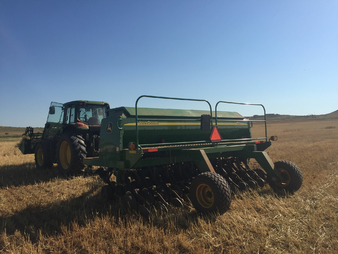Cover Crops a Valuable Resource
Posted: 8/3/2017
By Sydney Sleep

I visited home last weekend and was lucky enough to get in on planting some cover crops. My dad was planting a mix of turnips, radishes, pearl millet, and winter rye into a field of wheat that was recently cut and baled. We have never planted this mix of cover crops before, so it will be an experiment.
My dad had been studying cover crops for a while and decided this would be the best option for the soil and grazing. He chose to plant the radishes and turnips to help loosen up the soil because they have deep taproots. He added pearl millet to the mix to try to grow extra hay yet this year and because this type of millet responds well to irrigation. Rye was planted to graze after the millet is cut for hay.
Farmers use cover crops for many reasons, each with an opportunity to improve soil and protect land quality for the future. Some of the reasons to plant cover crops are to:
- Reduce soil erosion and runoff.
- Add active organic matter to soil.
- Protect water quality.
- Fix nitrogen in the soil.
- The deep taproots of some cover crops penetrate soil layers to reduce compaction.
- Provide a natural means of suppressing soil diseases, pests and weed growth.
- Yield quality material for grazing livestock or haying.
- Provide food and habitat for wildlife, pollinators, and beneficial insects.

Farmers have many options when it comes to choosing cover crops. Ultimately, it comes down to what goals they are trying to achieve and what works best for their farm and land.
Did you miss hearing Sydney on the radio? Listen to her segment here: 7.7.17 Sydney Sleep Cover Crops.mp3
Be sure to tune into KELO 1320 AM or 107.9 FM on Tuesdays each week during the 10:00 "It's your Agribusiness" show to hear The Farmer's Daughter.
